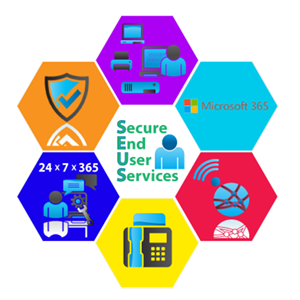 Delaware Department of
Delaware Department ofThe content of the webpage is currently under evaluation.
Please reach out to your DTI Customer Engagement Team with questions.
Information Technology Centralization (ITC) drives consistency and quality in the delivery of IT services while optimizing the state’s ability to leverage new technology rapidly and equitably. At the same time, ITC decreases redundant vendor purchases and limits the exposure of critical infrastructure and assets to cyber security risks.
In April 2021, the Department of Technology and Information (DTI) defined the forward strategy for IT centralization. Established as a phased approach, Phase I will deliver Secure End User Services (SEUS) which includes the foundational technologies required for a productive, secure workforce.
Email us with questions at DTI_IT_Centralization@delaware.gov.
ITC Strategy Is Focused On Secure End User Services
We are beginning with Secure End User Services (SEUS), which includes enterprise service solutions. Cyber security vulnerabilities heightened Delaware’s need to rapidly increase endpoint security due to many employees remotely connecting to the state network.
About ITC Secure End User Services

Secure End User Services (SEUS) equitably delivers the essential technologies and tools for a productive, secure State workforce. Agencies and workers benefit from standard enterprise tools, security, training, governance, and 24x7x365 support. SEUS is comprised of six enterprise components: Enterprise Service Desk, Enterprise Desktop, Network & Connectivity, Enterprise Voice, Email & Collaboration, and Security Suite.
These critical services are funded by a consumption-based (per-employee/month) cost recovery model.
WHAT “SERVICES” ARE IN SEUS?
Service Name Service Description Enterprise Service Desk: 24/7 Technical Support (Single Point of Contact – Incident Management, Request Fulfillment) Enterprise Desktop: End-User Devices, Printer Support, Active Directory & File Server Share Management, Software Patching & Lifecycle Management Network & Connectivity: LAN, WAN, Data, Remote Access Enterprise Voice: Enterprise Voice Services, Conferencing, Messaging Email & Collaboration: Email, Calendaring, Email Encryption, Enterprise Fax Services, Email File Storage Security Suite: Access/Identity Management, Network and Endpoint Security SEUS responds to ever increasing security threats by rapidly increasing network and endpoint security.
See the DTI Service Catalog for detailed descriptions of SEUS offerings.
From its creation of a single IT department over two decades ago, Delaware has moved steadily in the direction of centralizing and standardizing state technology systems and operations.
SEUS will be implemented in phases over the next several years.
Some services will need to be administered by state entities other than DTI. How will DTI ensure that these services comply with DTI standards and policies?
Centralization planning is facilitated in partnership with the agencies. A summary report detailing the agency IT landscape and recommended plan. All parties will actively discuss which services will transition to DTI and those that will remain with the agency. An agreed-upon Partner Service Policy will govern the compliance standards to assure that agency personnel experience the expected level of service.
How can agencies be assured that they will maintain their unique business technical knowledge despite the reallocation of their expert personnel to DTI?
DTI is committed to a positive customer experience during centralization activities. To maintain specific business IT knowledge, the agency and DTI will partner to create a staff transition plan. The plan ensures that tasks currently performed by an employee reallocating to DTI are transitioned to an employee within the agency. The approach will maintain the same due diligence as when a resource separates from service and knowledge transference is needed for remaining personnel.
Will agencies receive a Partnership Service Agreement (PSP) for individual service within SEUS or for the entire group of SEUS services?
Agencies will receive a PSP based upon their consumption of all services provided to them by DTI, including SEUS.
How will SEUS performance be measured and documented for agency partners?
Each agency will have access to newly refined SEUS performance metrics dashboard to follow agreed-upon service standards. Service levels are documented in the annual Partner Service Agreement.
After SEUS is fully implemented, what services will be centralized next?
DTI’s efforts are currently focused on planning and successfully implementing SEUS. The next phase of planning will be available in the future.
SB 153 expires next year, what happens if DTI is unable to complete ITC within the published timeline? Will there be an opportunity to extend the completion timeframe?
DTI is currently planning to extend the sunset clause for another term (e.g., end of the Carney Administration, 3 Years, etc.)
What happens to the previously gathered technical assessments? Will new assessments be required?
DTI will work with each agency to refresh data based on the scope of Secure End User Services. SEUS-related data (devices, users, etc.) will be requested at the appropriate time.
How will the SEUS rollout take place?
SEUS will be implemented over the next several years. The plan will entail collecting and analyzing the agency IT data, documenting recommendations, collaborating with the agency for a mutually agreeable plan, and executing the transition.
What are the fiscal next steps?
The DTI Fiscal team is preparing to test the Shared Service Cost Model through a showback billing during FY’23. This simulation will allow DTI and agencies to validate consumption as well as understand the cost of DTI-provided services and the chargeback methodology.